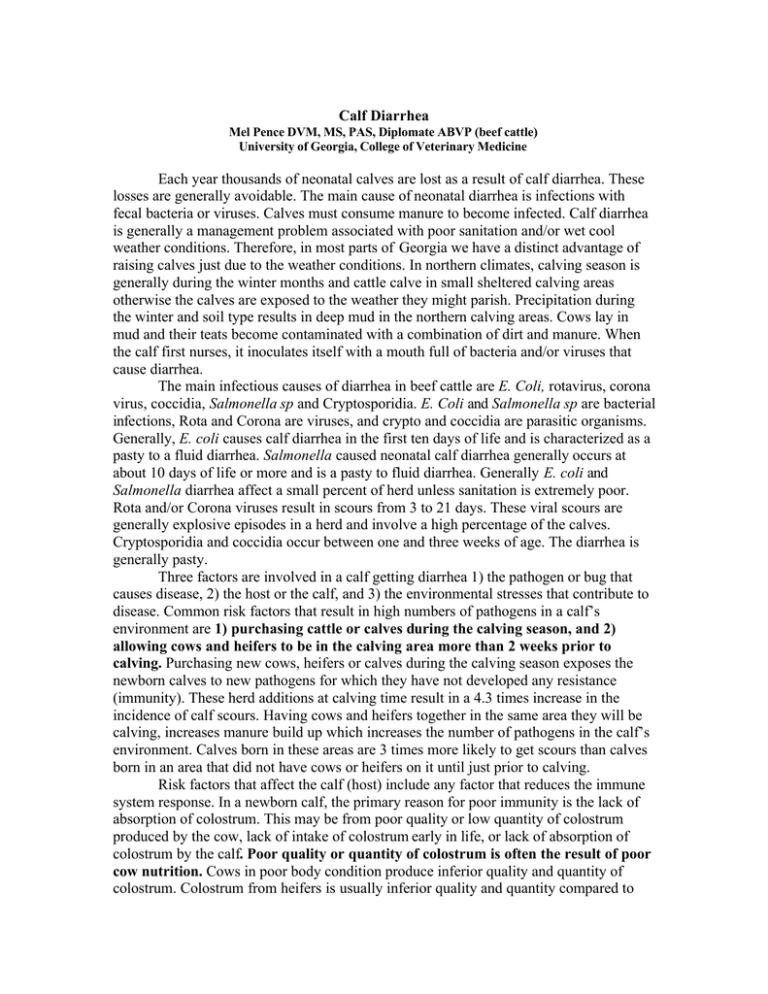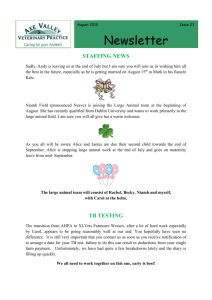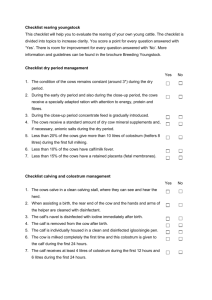Calf Diarrhea
advertisement

Calf Diarrhea Mel Pence DVM, MS, PAS, Diplomate ABVP (beef cattle) University of Georgia, College of Veterinary Medicine Each year thousands of neonatal calves are lost as a result of calf diarrhea. These losses are generally avoidable. The main cause of neonatal diarrhea is infections with fecal bacteria or viruses. Calves must consume manure to become infected. Calf diarrhea is generally a management problem associated with poor sanitation and/or wet cool weather conditions. Therefore, in most parts of Georgia we have a distinct advantage of raising calves just due to the weather conditions. In northern climates, calving season is generally during the winter months and cattle calve in small sheltered calving areas otherwise the calves are exposed to the weather they might parish. Precipitation during the winter and soil type results in deep mud in the northern calving areas. Cows lay in mud and their teats become contaminated with a combination of dirt and manure. When the calf first nurses, it inoculates itself with a mouth full of bacteria and/or viruses that cause diarrhea. The main infectious causes of diarrhea in beef cattle are E. Coli, rotavirus, corona virus, coccidia, Salmonella sp and Cryptosporidia. E. Coli and Salmonella sp are bacterial infections, Rota and Corona are viruses, and crypto and coccidia are parasitic organisms. Generally, E. coli causes calf diarrhea in the first ten days of life and is characterized as a pasty to a fluid diarrhea. Salmonella caused neonatal calf diarrhea generally occurs at about 10 days of life or more and is a pasty to fluid diarrhea. Generally E. coli and Salmonella diarrhea affect a small percent of herd unless sanitation is extremely poor. Rota and/or Corona viruses result in scours from 3 to 21 days. These viral scours are generally explosive episodes in a herd and involve a high percentage of the calves. Cryptosporidia and coccidia occur between one and three weeks of age. The diarrhea is generally pasty. Three factors are involved in a calf getting diarrhea 1) the pathogen or bug that causes disease, 2) the host or the calf, and 3) the environmental stresses that contribute to disease. Common risk factors that result in high numbers of pathogens in a calf’s environment are 1) purchasing cattle or calves during the calving season, and 2) allowing cows and heifers to be in the calving area more than 2 weeks prior to calving. Purchasing new cows, heifers or calves during the calving season exposes the newborn calves to new pathogens for which they have not developed any resistance (immunity). These herd additions at calving time result in a 4.3 times increase in the incidence of calf scours. Having cows and heifers together in the same area they will be calving, increases manure build up which increases the number of pathogens in the calf’s environment. Calves born in these areas are 3 times more likely to get scours than calves born in an area that did not have cows or heifers on it until just prior to calving. Risk factors that affect the calf (host) include any factor that reduces the immune system response. In a newborn calf, the primary reason for poor immunity is the lack of absorption of colostrum. This may be from poor quality or low quantity of colostrum produced by the cow, lack of intake of colostrum early in life, or lack of absorption of colostrum by the calf. Poor quality or quantity of colostrum is often the result of poor cow nutrition. Cows in poor body condition produce inferior quality and quantity of colostrum. Colostrum from heifers is usually inferior quality and quantity compared to that from mature cows. Vaccinating the cow or heifer with E. Coli, rota, corona and/or Clostridium perfringens vaccines can increase colostrum quality but these are only cost effective if you have the specific problem in your herd. The next most likely cause for poor immunity in a calf is the time and amount of nursing after birth. Calves need to nurse within a few hours (4-6 hours is ideal) after birth to absorb colostrum adequately. Chilling of the calf or a difficult birth will reduce the calf’s ability to absorb colostrum. Therefore, the calf may need assistance with nursing. The common host (newborn calf) risk factors for disease are 1) poor cow or heifer nutrition resulting in inferior colostrum 2) a heifer’s calves is 3.9 times as likely to develop scours as mature cow’s calves, and 3) calves that have difficult births are 12 times more likely to develop scours. Calf scours result in losses not only by increasing calf fatality, but also by a decrease in the calf’s ability to gain weight. There is a strong correlation between the amount of colostrum a calf receives and weight gain from birth to weaning. Work done by Drs. Baker and Vann at Tifton, GA showed that beef calves receiving and absorbing the correct amount of colostrum weighed an average of 60 pounds more at weaning than calves that did not get the correct amount of colostrum. Environmental risk factors for calf scours include anything that will stress the calf and therefore reduce its immune status. Lack of shelter during inclement weather, sudden changes in temperature, lack of drainage in the calving area are examples of environmental stresses. Prior planning and good management before and during the calving season can reduce the risk of losses due to calf scours and pneumonia. The bottom line is to have well managed cows and heifers in good body condition at calving and keep the calving environment clean.





